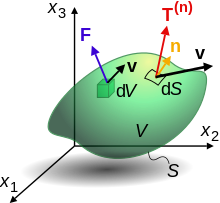Electromagnetic

Particle in a field
In Maxwell's equations, the forces between particles are mediated by electric and magnetic fields. The electromagnetic force (Lorentz force) on a particle with charge q due to a combination of electric field E and magnetic field B is
(in SI units).:2 It has an electric potential φ(r, t) and magnetic vector potential A(r, t). In the non-relativistic regime, its generalized momentum is
while in relativistic mechanics this becomes
The quantity is sometimes called the potential momentum. It is the momentum due to the interaction of the particle with the electromagnetic fields. The name is an analogy with the potential energy , which is the energy due to the interaction of the particle with the electromagnetic fields. These quantities form a four-vector, so the analogy is consistent; besides, the concept of potential momentum is important in explaining the so-called hidden-momentum of the electromagnetic fields
Conservation
In Newtonian mechanics, the law of conservation of momentum can be derived from the law of action and reaction, which states that every force has a reciprocating equal and opposite force. Under some circumstances, moving charged particles can exert forces on each other in non-opposite directions. Nevertheless, the combined momentum of the particles and the electromagnetic field is conserved.
Vacuum
The Lorentz force imparts a momentum to the particle, so by Newton's second law the particle must impart a momentum to the electromagnetic fields.
In a vacuum, the momentum per unit volume is
where μ0 is the vacuum permeability and c is the speed of light. The momentum density is proportional to the Poynting vector S which gives the directional rate of energy transfer per unit area:
If momentum is to be conserved over the volume V over a region Q, changes in the momentum of matter through the Lorentz force must be balanced by changes in the momentum of the electromagnetic field and outflow of momentum. If Pmech is the momentum of all the particles in Q, and the particles are treated as a continuum, then Newton's second law gives
The electromagnetic momentum is
and the equation for conservation of each component i of the momentum is
The term on the right is an integral over the surface area Σ of the surface σ representing momentum flow into and out of the volume, and nj is a component of the surface normal of S. The quantity Tij is called the Maxwell stress tensor, defined as
Media
The above results are for the microscopic Maxwell equations, applicable to electromagnetic forces in a vacuum (or on a very small scale in media). It is more difficult to define momentum density in media because the division into electromagnetic and mechanical is arbitrary. The definition of electromagnetic momentum density is modified to
where the H-field H is related to the B-field and the magnetization M by
The electromagnetic stress tensor depends on the properties of the media.













Comments
Post a Comment